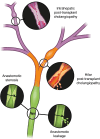Consensus classification of biliary complications after liver transplantation: guidelines from the BileducTx meeting
- PMID: 40313074
- PMCID: PMC12046073
- DOI: 10.1093/bjs/znae321
Consensus classification of biliary complications after liver transplantation: guidelines from the BileducTx meeting
Figures



References
-
- Samuel D et al. EASL clinical practice guidelines on liver transplantation. Jou Hepatol 2016; 81:1040–1086 - PubMed
-
- Mourad MM, Liossis C, Gunson BK, Mergental H, Isaac J, Muiesan P et al. Etiology and management of hepatic artery thrombosis after adult liver transplantation. Liver Transpl 2014;20:713–723 - PubMed
-
- Olthoff KM, Kulik L, Samstein B, Kaminski M, Abecassis M, Emond J et al. Validation of a current definition of early allograft dysfunction in liver transplant recipients and analysis of risk factors. Liver Transpl 2010;16:943–949 - PubMed
-
- Ploeg RJ, D'Alessandro AM, Knechtle SJ, Stegall MD, Pirsch JD, Hoffmann RM et al. Risk factors for primary dysfunction after liver transplantation–a multivariate analysis. Transplantation 1993;55:807–813 - PubMed
LinkOut - more resources
Full Text Sources

